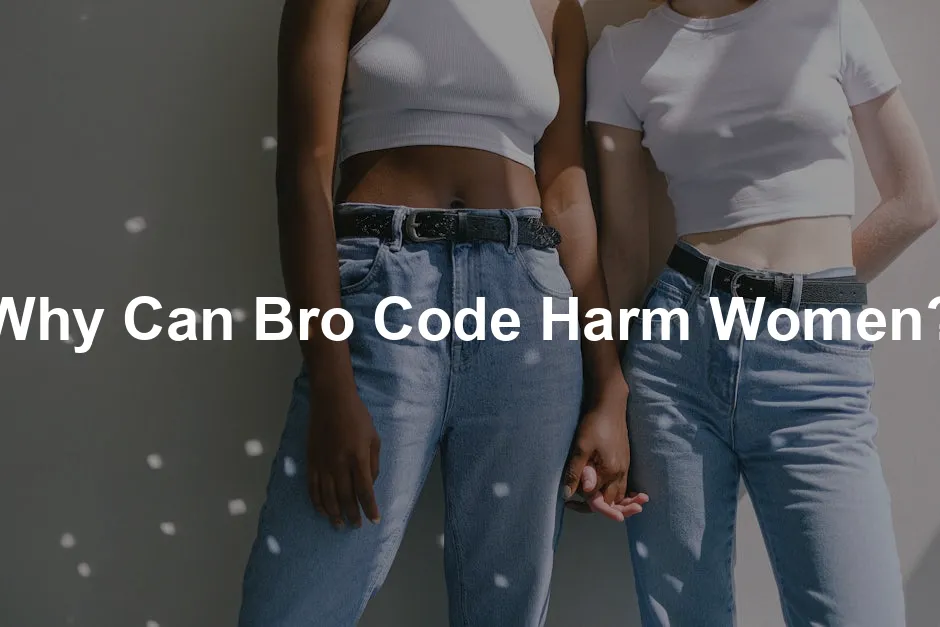
Why Can Bro Code Harm Women?
Introduction
“Bro code” refers to an unwritten set of rules governing male behavior. It often emphasizes loyalty among male friends above all else. This code can create an environment where harmful behaviors flourish, leading to a toxic culture. This culture, wrapped in humor and loyalty, reinforces toxic masculinity.
Toxic masculinity is a concept where traditional male behaviors come to symbolize dominance and aggression. When bro code embodies these traits, it can marginalize women, making them targets for harassment and violence. Women often find themselves at the mercy of these unspoken rules. The implications of bro code stretch far and wide, impacting women’s safety and emotional well-being.
This article aims to shed light on the harmful effects of bro code. We will examine how it affects women, society, and even men themselves. By understanding these dynamics, we can begin to challenge and change these harmful narratives.
Speaking of narratives, if you’re interested in exploring the complexities and humor of male friendships, check out The Bro Code: The First Rule of Fight Club. This book offers an entertaining perspective on male camaraderie and the unwritten rules that govern it.

Summary of Key Points
Bro code can have various detrimental impacts on women’s lives. It often leads to harassment and violence, creating an unsafe environment. This code encourages men to prioritize their loyalty to one another over the dignity and safety of women. As a result, women frequently face unwanted advances or worse, leading to an increased risk of violence.
Cultural conditioning plays a crucial role in perpetuating bro code behaviors. From a young age, boys learn that loyalty to their friends trumps concern for women. They see a male-dominated culture where women are objectified and disrespected, reinforcing harmful stereotypes. This conditioning creates a cycle that is hard to break.
Interestingly, bro code doesn’t just harm women; it also has negative effects on men’s emotional health and personal relationships. By adhering to rigid masculine norms, men often suppress their feelings. This emotional disconnect can lead to unhealthy friendships and relationships.
If you’re curious about understanding the emotional landscape of men, consider reading Men Are from Mars, Women Are from Venus. This book provides insights into the differences in communication styles between genders, helping bridge the emotional gap.
In the following sections, we’ll dive deeper into the various aspects of bro code. We will uncover the hidden consequences and explore ways to foster healthier relationships among men and women. Prepare to challenge preconceived notions and spark curiosity about this critical topic!

The Origins of Bro Code
Historical Context
The evolution of male friendships reveals a complex history. In patriarchal societies, men relied on one another for survival. Early humans worked together to hunt and gather. This need for collaboration laid the groundwork for what we now call bro code. Over time, these bonds morphed into a set of unwritten rules that govern male interactions.
Modern Interpretation
In today’s world, the bro code has transformed. It has become a modern set of rules that dictate male behavior. Society, media, and peer pressure reinforce these codes. Movies and TV shows often glamorize bro culture, leading many to believe that such behavior is acceptable. This cultural influence shapes how men see themselves and how they interact with women.
For a humorous take on male bonding, you might want to check out the classic film American Pie. It provides a comedic look at the lengths young men will go to in the name of friendship, even if it leads to awkward situations.
Understanding the origins and implications of bro code is essential. By recognizing its harmful effects, we can begin to challenge these norms and create a more equitable society.

The Toxicity of Bro Code
Misogyny and Objectification
Bro code often acts like a not-so-secret handshake for objectifying women. It sets a tone where women are seen as prizes rather than equals. This toxic mindset permeates male interactions, shaping how young boys perceive women from an early age.
Think of the classic locker room banter. Phrases like “bros before hoes” are the tip of an iceberg. They mask a deeper issue. This language trivializes women’s humanity, reducing them to mere objects of desire. It’s like viewing women as trophies in a game—winners take all, and losers, well, they don’t matter.
A recent study highlighted that boys, starting as young as 10, engage in behaviors rooted in this objectification. Examples abound: catcalling friends, crude comments at parties, or inappropriate jokes. These interactions may seem harmless but collectively contribute to a culture that normalizes misogyny.
Moreover, pop culture glorifies such attitudes. Movies and music often reinforce the idea that women are interchangeable. Such narratives bolster harmful stereotypes, showing that objectifying women is “just how guys are.” When men indulge in this banter, they not only objectify women but also shape a worldview where respect is an afterthought.
The Code of Silence
Now, let’s talk about the infamous “bro code of silence.” This unwritten rule often acts as a protective shield for toxic behaviors. When one bro witnesses another crossing the line, the typical response is silence. Why? Because loyalty to the “brotherhood” trumps the safety of women.
This silence can have devastating consequences. Consider the tragic case at Penn State, where fraternity members covered up a death rather than speak out. Such incidents are not isolated. Statistics reveal that many men remain complicit, allowing harassment and abuse to fester.
Women, on the other hand, are left to navigate this culture alone. They often bear the brunt of this silence, facing harassment without the support of their male peers. The burden falls unfairly on women to protect themselves in environments where men refuse to hold each other accountable.
A 2018 survey indicated that over 70% of women have experienced harassment in settings where bro culture is prevalent. This staggering number showcases the real-world impact of this code of silence. If men called out inappropriate behavior instead of remaining silent, the landscape could shift dramatically.

Emotional Disconnect
Another insidious element of bro code is the promotion of emotional suppression among men. This expectation often leads to unhealthy relationships, both with themselves and others. Men are taught to bottle up feelings. Crying? A sign of weakness. Sharing emotions? A no-go.
This emotional disconnect can have dire consequences. Studies reveal that men who adhere strictly to traditional masculine norms are more likely to experience mental health issues. Anxiety, depression, and even suicidal thoughts can stem from this inability to connect emotionally.
Experts emphasize the need for men to embrace vulnerability. It’s vital for creating healthier relationships. By suppressing emotions, men miss opportunities for connection, leading to loneliness and isolation.
If you’re looking for ways to enhance your emotional well-being, consider reading The Power of Vulnerability. This book offers profound insights into the importance of vulnerability and how it can lead to deeper connections.
The bro code creates a paradox. While it fosters camaraderie among men, it simultaneously prevents them from developing meaningful relationships. This emotional distance can erode friendships, leaving individuals feeling more isolated than ever.

In conclusion, the toxicity of bro code manifests in various harmful ways. From objectifying women to promoting silence and emotional disconnection, it creates an environment where both men and women suffer. Recognizing these issues is the first step towards fostering healthier interactions and relationships. Let’s break the code and build a culture of respect and empathy.
Cultural Influences on Bro Code
Media Representation
Media plays a crucial role in reinforcing and perpetuating the ideals of bro code. Films, music, and advertisements often glorify toxic masculinity, shaping societal attitudes toward women. For more on how cultural influences shape perceptions, check out why do cultural influences impact fear of public speaking in 2024.
Classic movies like *American Pie* and *Superbad* depict male characters engaging in behavior that objectifies women. These portrayals send a message that such actions are not only acceptable but also desirable. Viewers absorb these narratives, normalizing the idea that women exist for male pleasure. Speaking of which, *Superbad* is a hilarious take on teenage friendships and the lengths they go to, check it out here.
Music, too, is a significant conveyor of bro code ideals. Lyrics often celebrate misogyny, portraying women as mere objects. This cultural conditioning reinforces harmful stereotypes, contributing to a cycle of objectification and disrespect.
Furthermore, advertisements frequently depict women in demeaning ways. A study found that nearly 50% of ads reinforce stereotypes, showcasing women as submissive or overly concerned with their appearance. Such messaging perpetuates the notion that women’s value lies solely in their looks or availability to men.
In conclusion, media representation plays a pivotal role in shaping societal attitudes toward women and reinforcing bro code ideals. By recognizing and challenging these harmful narratives, we can begin to foster a culture of respect and equality. It’s time to change the script and redefine what it means to be a man.

The Bro Code’s Impact on Women’s Lives
Harassment and Violence
Bro code isn’t just a set of silly rules; it has serious consequences. Studies reveal a chilling connection between bro code and sexual harassment. Data shows that environments steeped in this culture see higher rates of harassment and violence. According to a 2018 survey, over 70% of women reported experiencing harassment in male-dominated spaces. That’s not just a statistic; it’s a reality that women face daily.
Take, for instance, the heartbreaking story of a young woman at a college party. She was surrounded by friends—her “bros.” When she turned down an advance from a guy, her friends laughed. They thought it was funny, but she felt deeply uncomfortable. Instead of support, she faced ridicule. This situation is not isolated. Research highlights numerous similar experiences. Women often find themselves navigating a minefield of unwanted attention and aggression fueled by bro code mentality.
Another striking example comes from a study examining fraternity culture. It found that 70% of fraternity members witnessed or experienced harassment, yet many remained silent. This silence perpetuates the cycle of violence. When men choose loyalty over accountability, they enable harmful behaviors, leaving women vulnerable.
Emotional Labor
Navigating male-dominated spaces can be emotionally taxing for women. They often bear the weight of managing the emotional fallout from bro code behavior. This burden translates into significant emotional labor. Women feel they must remain vigilant and self-reliant, constantly assessing their surroundings for potential threats.
Imagine a woman attending a work event. She’s the only female in a group of men. The conversation turns to inappropriate jokes about women, and she’s caught in a dilemma. Should she speak up and risk alienation or stay silent to fit in? This scenario illustrates the emotional toll that bro culture imposes. It pressures women to choose between their values and social acceptance.
Such dynamics can severely impact women’s mental health. A 2021 report indicated that women in male-dominated workplaces experience higher rates of anxiety and depression. The constant need to navigate these uncomfortable interactions takes a toll. Relationships with men, too, can suffer. Trust erodes when women feel their male counterparts prioritize the bro code over respect and empathy.
Moreover, this emotional burden doesn’t just affect individual women. It has broader implications for workplace culture and society. Women may withdraw from male-dominated spaces altogether, missing opportunities for advancement and collaboration. The emotional labor required to conform to a hostile environment becomes too much.
In summary, the bro code’s influence extends beyond the individual. It creates an environment where harassment flourishes and emotional labor becomes a daily struggle for women. This dynamic not only affects women’s safety but also stifles their potential, leading to a culture where women are left to shoulder the emotional fallout from toxic masculinity. It’s high time for change.

Breaking the Bro Code
The Role of Men
Let’s face it: bro code isn’t just a playful set of rules. It can be a harmful game. Men must step up and challenge these behaviors among their peers. It’s time to put the brakes on loyalty that puts women at risk. Instead, let’s cultivate a culture of respect and accountability.
Allyship plays a crucial role here. Men need to recognize that their voices matter. When they witness inappropriate behavior, they should call it out. This isn’t about being a snitch; it’s about being a decent human being. Silence only empowers the harmful actions of others.
Consider this: when a man holds his friend accountable for disrespecting women, he sets a precedent. He shows that real brotherhood doesn’t tolerate misogyny. This accountability helps dismantle the toxic environment that bro code perpetuates.
It’s not just about saying the right things; it’s about taking action. Men can create safe spaces for women by supporting their rights and experiences. This shift in mindset benefits everyone. When women feel safe, they can thrive, and so can the men who support them.

Alternatives to Bro Code
Now, let’s talk about healthier models of male friendship. Imagine friendships built on mutual respect and equality. Sounds refreshing, right? Men can redefine their relationships by focusing on emotional connection rather than competition.
First, open communication is key. Men can practice sharing their feelings and experiences with one another. This vulnerability fosters deeper connections. It encourages men to lean on each other for support, rather than hiding behind a façade of toughness.
Next, reject the notion that male friendships must come at a woman’s expense. Instead, celebrate healthy relationships with women. Treat them as equals, not just as objects of interest or competition.
Finally, engage in activities that promote inclusivity. Invite women into male spaces, whether it’s a game night or a discussion group. This helps break down barriers and fosters understanding.
By embracing these alternatives, men can cultivate friendships that uplift everyone involved. It’s about time we shift the narrative from bro code to one that champions respect and equality.

FAQs
What is bro code?
Bro code is an unwritten set of rules guiding male friendships. It emphasizes loyalty, camaraderie, and often prioritizes male bonds over other relationships. While it can foster strong male friendships, it often leads to toxic behaviors and reinforces harmful stereotypes about masculinity. This code can create an environment where women are objectified and mistreated, making it essential to understand its implications.
How does bro code affect women?
Bro code profoundly impacts women’s safety and emotional well-being. It encourages behaviors that contribute to harassment and violence, leaving women vulnerable in social situations. Many women find themselves navigating uncomfortable environments where their concerns are often dismissed. The loyalty demanded by bro code can lead to silence among men when witnessing inappropriate behaviors, further endangering women and reinforcing a culture of misogyny.
Can men be harmed by bro code?
Absolutely! The bro code isn’t just damaging to women; it negatively impacts men too. It promotes emotional suppression, leading to mental health issues like anxiety and depression. Men feel pressured to conform to rigid standards of masculinity, which can isolate them and hinder genuine connections. This culture can also create unhealthy dynamics in friendships, where emotional vulnerability is seen as weakness.
What can be done to change the culture of bro code?
Changing the culture of bro code starts with individual actions. Here are some small but impactful steps: Speak Up: If you witness inappropriate behavior, call it out. Silence is complicity. Encourage Vulnerability: Create a safe space for men to express their feelings without judgment. Challenge Misogyny: Don’t laugh at sexist jokes or comments. Take a stand and promote respect for all individuals. Educate Others: Share insights about the negative impacts of bro code with friends and peers. Awareness is the first step toward change. By taking these steps, we can collectively dismantle bro code and promote a culture of respect and empathy. Let’s foster healthier relationships for everyone, one conversation at a time.
Please let us know what you think about our content by leaving a comment down below!
Thank you for reading till here 🙂
All images from Pexels




